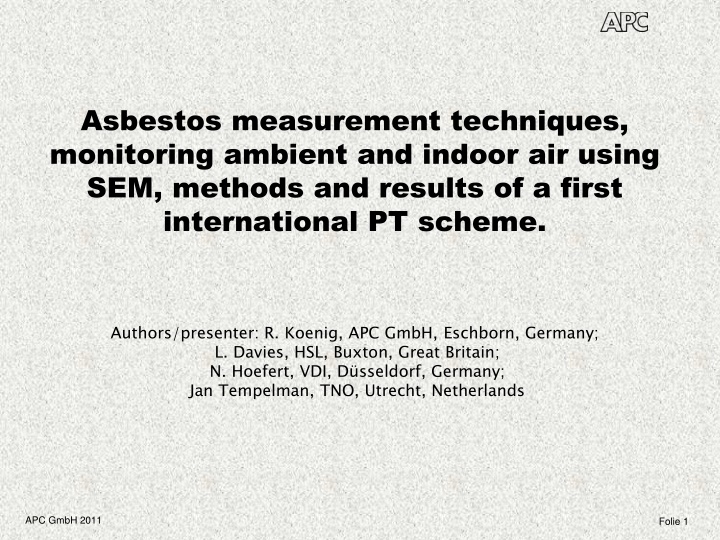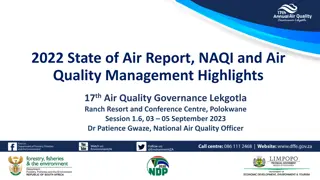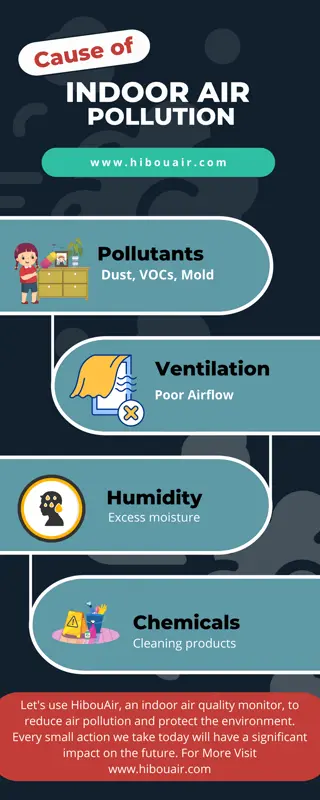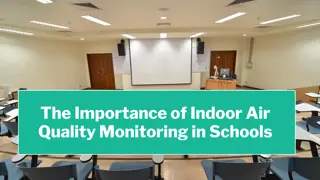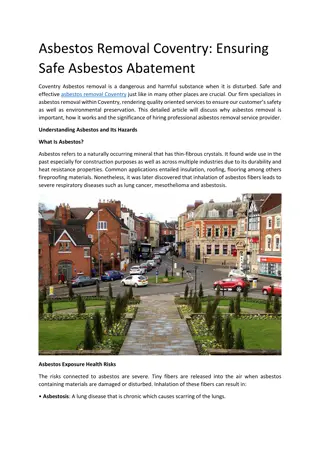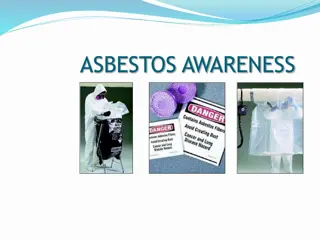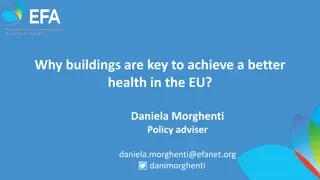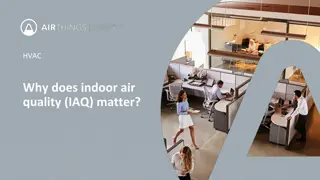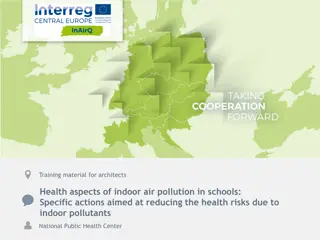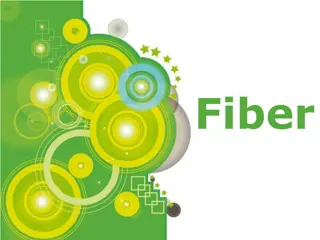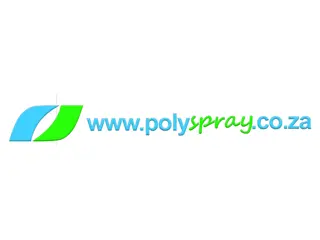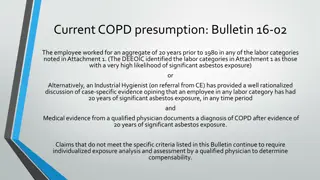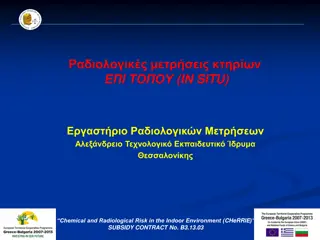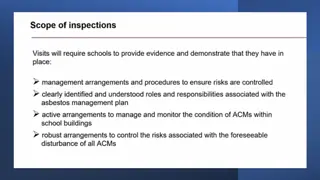Techniques for Monitoring Asbestos Fiber Concentration in Ambient and Indoor Air using SEM
Explore the methods and results of an international proficiency testing (PT) scheme for measuring asbestos fibers in indoor and ambient air. The use of Scanning Electron Microscope (SEM) based techniques, including ISO 14966 and VDI 3492 guidelines, is discussed. The importance of PT schemes in ensuring accurate and comparable results, along with the challenges faced in producing suitable filters, is highlighted. A collaborative effort by APC, VDI, TNO, and HSL led to the development of an SEM PT scheme based on ISO 14966.
Download Presentation

Please find below an Image/Link to download the presentation.
The content on the website is provided AS IS for your information and personal use only. It may not be sold, licensed, or shared on other websites without obtaining consent from the author.If you encounter any issues during the download, it is possible that the publisher has removed the file from their server.
You are allowed to download the files provided on this website for personal or commercial use, subject to the condition that they are used lawfully. All files are the property of their respective owners.
The content on the website is provided AS IS for your information and personal use only. It may not be sold, licensed, or shared on other websites without obtaining consent from the author.
E N D
Presentation Transcript
Asbestos measurement techniques, monitoring ambient and indoor air using SEM, methods and results of a first international PT scheme. Authors/presenter: R. Koenig, APC GmbH, Eschborn, Germany; L. Davies, HSL, Buxton, Great Britain; N. Hoefert, VDI, D sseldorf, Germany; Jan Tempelman, TNO, Utrecht, Netherlands APC GmbH 2011 Folie 1
ISO 14966 / VDI 3492 The above mentioned guidelines (with some modifications) using Scanning Electron Microscope (SEM) based measurement methods are widely used for the determination of the asbestos fibre concentration in indoor and ambient air in Germany and to some extent in some of its neighboured European countries APC GmbH 2011 Folie 2
PT Schemes The results of measurements of the asbestos fibre concentration are used to make decisions, which may result in financial and economical consequences, in addition to the health effects of workers and others. APC GmbH 2011 Folie 3
PT Schemes As a result it is critical, that laboratories operating in this field are giving comparable results. It is therefore surprising, that -with the exception of two round robins in Germany during the 1990 s - no regular PT scheme is available for this technique. APC GmbH 2011 Folie 4
PT Schemes The main reason for this is the technical difficulty of producing large numbers of filters each with equivalent fibre densities, in a suitable concentration range and at a reasonable cost. APC GmbH 2011 Folie 5
PT Schemes To address this problem a small consortium of interested parties was formed (namely APC and VDI in Germany, TNO in the Netherlands and HSL in the UK), with the remit of developing a suitable SEM PT scheme. APC GmbH 2011 Folie 6
ISO 14966 PT Scheme From the beginning we were aiming for an international acceptable scheme, therefore the basis was ISO 14966, being also very similar to VDI 3492 and other SEM methods APC GmbH 2011 Folie 7
ISO 14966 PT Scheme The intention was to produce a larger number of equally loaded filter cassettes with fibre concentrations up to 50 fibres / mm filter area. The sample set for the participants shall include at least three filter cassettes having different qualities both in fibre number and asbestos type on the filter. APC GmbH 2011 Folie 8
ISO 14966 PT Scheme (steps included) APC GmbH 2011 Folie 9
ISO 14966 PT Scheme (production of loaded filter cassettes) Sample production is achieved by HSL using a combination of a modified dustiness tester to generate airborne fibre concentrations and a multi-port sampling device the Sputnik . A combination of commercial asbestos containing materials and specially prepared spiked materials was the source for generating the dust for the filter loading APC GmbH 2011 Folie 10
ISO 14966 PT Scheme (production of loaded filter cassettes) Using a critical orifice and a sampling flow rate of around 1.8 litres per minute, the sputnik has the capability to collect up to 114 equally loaded filters (mounted in cassettes), in one batch. In the first pilot PT scheme two differently loaded filters were used together with an ambient air filter generated by parallel sampling at the same location. APC GmbH 2011 Folie 11
ISO 14966 PT Scheme (production of loaded filter cassettes) APC GmbH 2011 Folie 12
Pilot PT Scheme Organisation Production of filter cassettes HSL Buxton GB Test for homogenity and fibre density APC Eschborn TNO Utrecht NL Coding of filters Assembling the filter sets APC Sending the parcel with the filter set VDI D sseldorf Evaluation of the filters Sending results PARTICIPANT Anonymisation of results VDI Evaluation of data APC Presentation of results to the Participants VDI APC GmbH 2011 Folie 13
ISO 14966 PT Scheme Additional Information Package An additional information package was sent together with the samples, to ensure with other things, that the counting rules are well understood. Most people use WHO counting rules in their every day business, which are different in some cases from ISO counting rules APC GmbH 2011 Folie 14
Pilot PT Scheme ISO 14966 During this first trial the number of participants was limited to 15 laboratories, representing five European countries (Austria, Germany, Great Britain, Netherlands and Switzerland). APC GmbH 2011 Folie 15
P Pilot PT ilot PT Scheme Fibre Scheme ISO 14966 Fibre numbers ISO 14966 Results numbers (L > 5 m) Results (L > 5 m) Ambient air R 24 R 25 Evaluated filter area mm2 Laboratory Other In. Asbestos Other In Asbestos Other In. Asbestos A 22 0 1 6 22 30 1,05 B 0 0 0 10 0 32 1,04 C 8 0 3 6 2 31 1,03 D 5 0 0 7 2 22 1,01 E 3 0 0 11 1 42 1 F 0 0 4 13 11 18 1 G 0 0 0 10 0 18 1 H 1 0 1 3 0 16 1,01 I 7 1 0 9 5 38 1 K 0 0 0 5,3 0 12,9 1,7 L 0 0 0 5 0 24 1,01 N 0 0 0 8 1 14 1,01 O 0 0 0,5 2,7 0 7,7 1,83 P 11 0 3 8 1 36 1 Q 1 0 1 9 0 26 1 green numbers: calculated for 1 mm evaluated filter area APC GmbH 2011 Folie 16
Distribution of fibre diameter (asbestos) as detected by the participants 0.40 0.35 F r e q u e n c y % / m 0.30 0.25 0.20 %/ m 0.15 0.10 0.05 0.00 0 0.5 1 1.5 2 2.5 3 Fibre Diameter [ m] APC GmbH 2011 Folie 17
Pilot PT Scheme ISO 14966 Asbestos varieties in the sample: 50 % crocidolite 45% amosite 5% chrysotile APC GmbH 2011 Folie 18
Pilot PT Scheme ISO 14966 Results Observed Deviations: Observed Deviations: In a simple estimation the deviation SR resulting from the evaluation by the participants extending the unavoidable poissonian random variation SPcan be calculated: ( R S S = ) 2 N 2 P S where SNis the standard deviation of the counting results for one filter type APC GmbH 2011 Folie 19
Pilot PT Scheme ISO 14966 Results Observed deviations in between comparison: Observed deviations in between- -laboratory comparison: laboratory For the ambient air filters no deviation extending the poissonian uncertainty detectable For the filter type R 24 the variation SR, which results from the between-laboratory comparison of the fibre counts is: appr. 10% relative For R 25 the variation SRis appr. 30% relative APC GmbH 2011 Folie 20
Pilot PT Scheme ISO 14966 Results Detected reasons for the observed variations: Detected reasons for the observed variations: Laboratories with a tendency to be lower than average (asbestos) show two types of discernable deviations: Smallest detected fibre diameter is 0,3 m or greater according to their fibre counting form. or they record a larger amount of fibres with no spectra = unidentified objects APC GmbH 2011 Folie 21
Pilot PT Scheme ISO 14966 Results Reasons for the observed variations: Reasons for the observed variations: Optimization of EDXA instruments required: Greater channel width (20 eV or even more) gives maximum P/B in shortest possible measurement time and is especially important for the analysis of very thin fibres, to minimize statistical uncertainties in the spectra and to reduce the adverse effects of beam drift during analysis. APC GmbH 2011 Folie 22
ISO 14966 Optimization of EDXA instruments required: APC GmbH 2011 Folie 23
Optimization of EDXA instruments Optimization of EDXA instruments APC GmbH 2011 Folie 24
Optimization of EDXA instruments Optimization of EDXA instruments APC GmbH 2011 Folie 25
Pilot PT Scheme ISO 14966 Summary The pilot PT scheme was running as scheduled For a first PT scheme including both preparation and analysis of the filter samples the results can be regarded as good, especially in the range of the decision limits (clearance levels as an example) in Germany and some of its neighbored countries. Based on the experience HSL (Health and Safety Laboratory) will offer a full scale PT scheme starting out later this year. APC GmbH 2011 Folie 26
Thank you for your attention ! APC GmbH 2010 Folie 27
